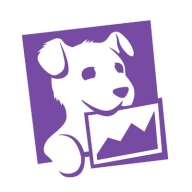

Datadog and InfluxDB compete in the monitoring and analytics category. Datadog has the upper hand due to its comprehensive monitoring tools and robust integration capabilities while InfluxDB excels in real-time analytics for time-series data.
Features: Datadog stands out with its extensive monitoring tools, including sharable dashboards, flexible alerting systems, and automation features. It integrates seamlessly with various cloud services. InfluxDB is praised for its time-series data management, lightweight architecture, and integration ease with visualization tools like Grafana, making it ideal for real-time analytics.
Room for Improvement: Datadog users suggest improvements in cost management tools, real-time metrics insights, and simplification of complex interfaces. InfluxDB needs better support for high-cardinality data, enhanced query language compatibility, and improvements in clustering and high availability options.
Ease of Deployment and Customer Service: Datadog supports multi-cloud deployments and offers comprehensive documentation and customer support, though technical support responsiveness varies. InfluxDB, mainly deployed on-premises and public clouds, provides average support, with noted response delays and a steeper learning curve due to its open-source nature.
Pricing and ROI: Datadog operates on a pay-as-you-go model, which can become expensive, necessitating careful cost management despite providing excellent observability benefits. InfluxDB offers a low-cost entry with its open-source version, but scaling costs rise, especially for cloud deployments, impacting cost-benefit assessments.


Datadog is a comprehensive cloud monitoring platform designed to track performance, availability, and log aggregation for cloud resources like AWS, ECS, and Kubernetes. It offers robust tools for creating dashboards, observing user behavior, alerting, telemetry, security monitoring, and synthetic testing.
Datadog supports full observability across cloud providers and environments, enabling troubleshooting, error detection, and performance analysis to maintain system reliability. It offers detailed visualization of servers, integrates seamlessly with cloud providers like AWS, and provides powerful out-of-the-box dashboards and log analytics. Despite its strengths, users often note the need for better integration with other solutions and improved application-level insights. Common challenges include a complex pricing model, setup difficulties, and navigation issues. Users frequently mention the need for clearer documentation, faster loading times, enhanced error traceability, and better log management.
What are the key features of Datadog?
What benefits and ROI should users look for in reviews?
Datadog is implemented across different industries, from tech companies monitoring cloud applications to finance sectors ensuring transactional systems' performance. E-commerce platforms use Datadog to track and visualize user behavior and system health, while healthcare organizations utilize it for maintaining secure, compliant environments. Every implementation assists teams in customizing monitoring solutions specific to their industry's requirements.
InfluxDB is open-source software that helps developers and enterprises alike to collect, store, process, and visualize time series data and to build next-generation applications. InfluxDB provides monitoring and insight on IoT, application, system, container, and infrastructure quickly and easily without complexities or compromises in scale, speed, or productivity.
InfluxDB has become a popular insight system for unified metrics and events enabling the most demanding SLAs. InfluxDB is used in just about every type of industry across a wide range of use cases, including network monitoring, IoT monitoring, industrial IoT, and infrastructure and application monitoring.
InfluxDB offers its users:
InfluxDB Benefits
There are several benefits to using InfluxDB . Some of the biggest advantages the solution offers include:
Reviews from Real Users
InfluxDB stands out among its competitors for a number of reasons. Two major ones are its flexible integration options and its data aggregation feature.
Shalauddin Ahamad S., a software engineer at a tech services company, notes, “The most valuable features are aggregating the data and the integration with Grafana for monitoring.”
We monitor all Network Monitoring Software reviews to prevent fraudulent reviews and keep review quality high. We do not post reviews by company employees or direct competitors. We validate each review for authenticity via cross-reference with LinkedIn, and personal follow-up with the reviewer when necessary.